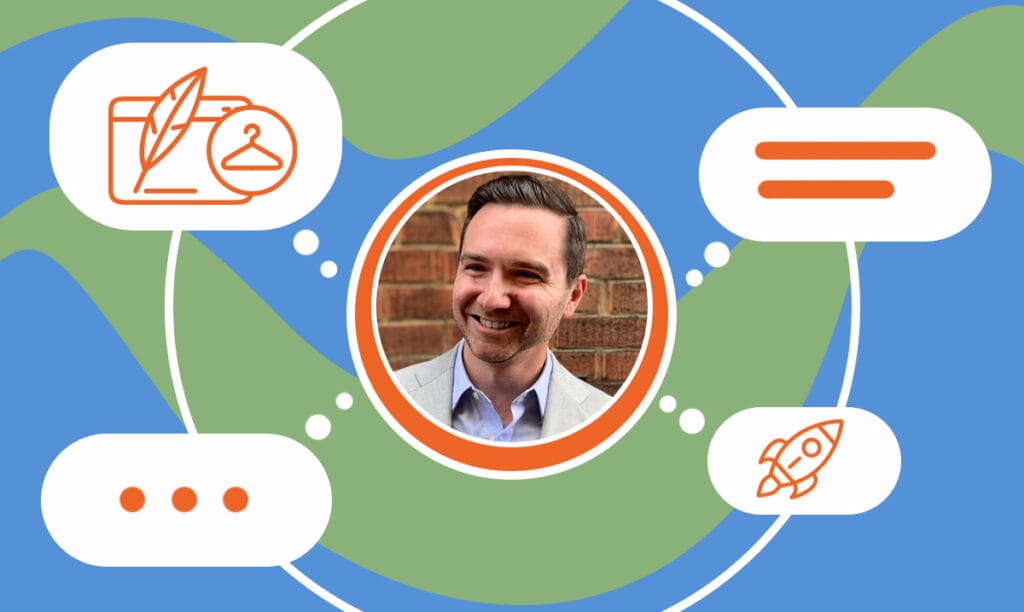Discover the creative mind and journey behind Red Ted Art, a beloved crafting blog that has captured the hearts of parents and children alike. Inthi ...
The R.J. Weiss Journey in Personal Finance Blogging
Written by: Howard Tillerman
Howard Tillerman is the Chief Marketing Officer for Step By Step Business and an award-winning marketing professional.
Published on November 24, 2023

In a digital landscape brimming with voices and views, standing out is no small feat — especially in the world of personal finance blogging. Yet, R.J. Weiss has not only emerged but thrived, steering The Ways to Wealth into a beacon for those navigating the often tumultuous waters of financial wisdom. Today, we sit down with the founder and senior editor himself, delving into the intricacies and insights that have shaped both his journey and the blog’s success.
From the initial spark that ignited The Ways to Wealth to the ever-evolving strategies that keep it relevant and engaging, R.J. Weiss offers a window into the world of successful blogging. He discusses how he carved a niche in the crowded financial blogosphere, the content strategy that resonates with his audience, and the monetization methods that fuel the blog’s growth.
But this is more than just a story of success; it’s a tale of overcoming challenges, engaging with a community, and forecasting the future of online entrepreneurship. As we explore the tools, tactics, and tenacity required to sustain a successful blog, R.J. Weiss shares invaluable advice for aspiring bloggers and his vision for The Ways to Wealth in the years to come.
Join us as we unravel the journey, strategies, and aspirations behind one of the most insightful voices in personal finance blogging, learning what it takes to not just start a blog but to make it a cornerstone in its niche.
Journey to Blogging
SBS – What inspired you to start The Ways to Wealth, and how did your previous experiences shape your approach to this blog?
R.J. – I started The Ways to Wealth because I was really into reading bloggers’ income reports.
Seeing their success made me think about starting my own blog. Also, I was and still am a big fan of Pat Flynn. He was building a niche site then and publishing income reports on the progress, and I resonated with the idea. I decided to try something similar to diversify my income.
Success looked like making an extra $1,000/month at that point.
The original idea for the blog was to make reading lists from famous bloggers and entrepreneurs. I’ve always loved reading, especially books on finance and investing. I’ve read so many of them and always enjoy finding new ones. So, why not combine these two interests?
The blog began with these reading lists, which lists like our best business books and best investing books remain some of our most popular. But as I got more into blogging, I saw how things worked and the different ways you could make money.
That’s when I decided to change from just a small site about book lists to a full personal finance site, focusing on making money through affiliate partnerships.
Identifying the Niche
SBS – How did you identify your niche in the crowded personal finance blogging space, and what advice would you give to others trying to find their unique angle?
R.J. – Picking that perfect niche is almost impossible without gaining some industry expertise. This means that sometimes, you just need to dive in with an idea, however broad or basic.
Initially, I focused on finance books, but I chose a domain name that allowed me to cover broader finance topics.
The real shift in my strategy came a few months after I launched The Ways To Wealth. With growing experience, I began to see the opportunity in the broader affiliate space rather than just books.
Content Strategy
SBS – What is your process for developing content, and how do you ensure it remains relevant and engaging to your audience?
R.J. – Our approach to creating content at The Ways To Wealth first focuses on what our readers want to know. We consider their questions and then find keywords that match these questions.
The goal is to pick keywords that many people are searching for, but not many sites are covering — the less competition, the better our chance to appear in search results.
We use tools like Ahrefs to help us find these keywords, but the real starting point is always thinking about what’s on our readers’ minds.
In today’s world, to be really good at getting traffic from search engines, you need to give readers all the answers they’re looking for in one place.
For example, if we’re writing about why a certain product isn’t great, we don’t just leave it at that.
We also talk about better alternatives and review similar products. This way, our readers don’t have to go back to Google to search again. We aim to be the only site they must visit for certain topics. Focusing on a few specific verticals ensures our site is the go-to place for those topics.
Monetization Strategies
SBS – Can you describe the different ways you monetize your blog and which method you found most effective?
R.J. – Our blog makes money mainly through affiliate revenue and advertising. Affiliate revenue is the bigger chunk, making up about 70% of our income, while advertising covers the remaining 30%.
The most effective method for us to drive revenue is to be the last click for someone ready to sign up for a product, like with our page on best free stock offers.
Here, visitors are usually highly motivated and are ready to sign up for a brokerage, making them more likely to use our affiliate links.
We also have content that’s not as directly linked to sales but supports our main pages. This content completes the reader’s journey and supports the more direct, bottom-of-the-funnel content that drives most of our affiliate revenue.
Building Traffic
SBS – What strategies have been most successful in driving traffic to your site, and how has this evolved over time?
R.J. – When we first started out, we relied heavily on social media and Pinterest to drive initial traffic while we worked on building authority with search engines. Pinterest was especially valuable early on, thanks to the highly visual nature of personal finance content. We would create infographics and other image-based content perfect for the Pinterest audience.
However, after several years of focusing on high-quality, comprehensive content that answered reader questions, Google began driving more and more organic traffic to our site. The traffic was more targeted, too — people searching for specific financial topics and ready to take action.
While we do some paid advertising on Facebook, SEO has become our main traffic and revenue driver. There’s no replacing that direct stream of motivated visitors from search engines.
SEO Tactics
SBS – How important has search engine optimization (SEO) been for your blog’s growth, and could you share some effective SEO tactics?
R.J. – Simply put, SEO is the lifeblood of our business.
My top SEO tactic is creating high-quality content that answers users’ questions precisely.
With over a decade working in finance, I’ve had countless conversations with people about various financial topics. This experience has given me deep insight into people’s questions and concerns when seeking personal finance advice.
In our content, I aim to address those underlying issues directly instead of just targeting keywords. For example, if someone searches “Is Acorns worth it,” many sites will simply review Acorns without investigating whether micro-investing apps can help you achieve financial goals.
We strive to provide that level of thoughtful analysis tailored to the reader’s true needs.
Additionally, I pay close attention to the searcher’s intent for each keyword and topic to create content that matches what the user wants at that moment. If the query is informational, we’ll use an educational tone and include actionable tips. If it’s commercial, where the visitor intends to purchase, we’ll focus more on product comparisons and user-friendly affiliate links.
Understanding searcher intent helps ensure we provide the right information at the right time to offer the best user experience.
Engaging the Audience
SBS – What methods do you use to engage with your readers and build a loyal community?
R.J. – One of the most valuable assets we’ve built through The Ways to Wealth is the tribe of loyal readers through email. Our email list stands at around 20,000 subscribers. This direct line of communication to an engaged audience has been incredibly beneficial for promoting new content and building relationships.
While I don’t inundate our email subscribers with too many messages, I regularly highlight newly published content that would interest most of our readers. This provides value to them while also driving more visitors to the site.
Additionally, we’ve created comprehensive email courses or “welcome series” around some of our most popular verticals, such as travel hacking. This multi-part email series takes beginners step-by-step through the basics of how to maximize travel rewards.
Overcoming Challenges
SBS – What were some of the biggest challenges you faced in the early days of your blog, and how did you overcome them?
R.J. – One of the biggest challenges I faced in the early days was recovering when The Ways to Wealth got hit by a Google update in late 2019. Up to that point, organic search traffic had been growing steadily. However, the November 2019 core update significantly impacted our visibility.
In hindsight, it was a clear signal that we needed to improve our content quality and authority to compete in the crowded personal finance space. But at the time, it felt devastating to lose a major traffic channel overnight.
I overcame that obstacle by doubling down on creating stellar content that offered true value for readers.
We combed through every article on the site, strengthening any weak or low-quality posts. I brought on an exceptional managing editor with a journalism background to oversee content strategy. We also expanded our team of freelance writers and implemented much more rigorous editing and fact-checking processes.
It was a heavy lift requiring major resource investment. But the focus on value-first content above all else eventually regained Google’s trust. By late 2021, we were seeing all-time high levels of organic traffic. And we haven’t been significantly impacted by an update since.
Digital Tools and Resources
SBS – What tools or resources do you consider essential for someone starting a blog today?
R.J. – The tools I’d recommend for beginners are:
- Ahrefs: For SEO and affiliate site builders, Ahrefs is invaluable. Its robust keyword research capabilities allow you to identify high-potential topics to target and build content. You can also use it to conduct detailed audits of internal linking structures. The rank-tracking feature becomes useful for gauging your progress as your site grows
- Grammarly: While it’s not the flashiest tool, it is a huge time saver. The free version helps you avoid embarrassing typos or grammatical mistakes that can undermine your site’s professionalism
- MidJourney: This AI image generator creates stunning featured images. Visuals are vital for standing out, and MidJourney saves tons of design time and money
- Claude: When reviewing complex financial products like bank bonuses, I rely heavily on Claude rather than trying to parse each lengthy terms and conditions document manually. My process is first to draft bonus offer recommendations based on initial research. I then upload each offer’s full promotion details and legal fine print into Claude. Claude scans and cross-checks thousands of words within seconds across multiple company T&Cs to validate the key accuracy of eligibility factors, payout rules, etc, that I cited. Unlike ChatGPT, which can struggle with large texts, Claude provides invaluable peace of mind that I’m equipping readers with reliable guidance about the best financial promotions
Balancing Quality and Quantity
SBS – How do you balance the need for regular content updates with maintaining high-quality posts?
R.J. – As The Ways to Wealth has grown, my role has shifted from writing new articles to updating existing posts.
We have an excellent group of long-time freelance writers who draft initial content. My full-time managing editor then vets these drafts for issues, assigns revisions if needed, and routes finalized posts to me.
At that point, I review each piece to ensure it meets our standards for providing maximum value to readers — not just grammatically correct but truly useful, accurate, and deeply informative.
All this frees up my time to update the site’s content.
Future Trends
SBS – Based on your experience, what trends do you see emerging in blogging or online entrepreneurship?
R.J. – One of the most exciting developments shaping the future of blogging and online business is the rapid advancement of large language models (LLMs) like ChatGPT.
These AI tools currently can only recycle and repurpose content that humans have created previously. This limitation has influenced my team’s approach — we are shifting to focus less on targeting keywords that have been extensively covered. Instead, we brainstorm original angles and questions that smart AI tools can’t match.
For example, our recent article, “15 Hot New Small Business Ideas to Start With Little Money in 2024,” is hard to replicate because it’s based on future trends that not many people are discussing.
Pushing originality is now a priority across all our ideation processes. We aim to share experienced perspectives and insights that cannot be replicated.
These AI advancements will pressure online entrepreneurs and bloggers to tap deeper into their expertise and creativity. Those leveraging unique life experiences to provide novel analyses while establishing quality standards LLMs can’t match will have sustainable success.
Advice for Beginners
SBS – What is the one piece of advice you would give to someone just starting out with their blog?
R.J. – The number one piece of advice I’d offer anyone just starting out is to simply begin creating, even if you don’t have a clear path yet. When I first launched The Ways to Wealth, my focus was simply sharing book recommendations. However, as I began actively publishing content and attracting an initial audience, I noticed more lucrative opportunities in affiliate marketing around financial products.
Similar to how I pivoted from book reviews into broader personal finance topics, new bloggers should remain flexible and willing to evolve over time. Test different content types, traffic sources, and monetization models. Track what resonates and what doesn’t.
Patterns will emerge, revealing the route best matched to your unique talents and interests.
But too many aspiring bloggers get stalled out endlessly strategizing and worrying about identifying some theoretical “perfect” niche before creating their first post. You will uncover what works for you only through first-hand trial and error. So don’t fret about nailing it right away — start churning out content, adapt to lessons learned, and let your innate strengths guide you to that sweet spot niche as you grow.
Long-Term Vision
SBS – Where do you see The Ways to Wealth in the next five years, and what are your long-term goals for the blog?
R.J. – Thinking ahead five years, my wildly ambitious goal for The Ways to Wealth is to have it regarded as the most trusted personal finance site for everyday people — essentially the “Consumer Reports” of personal finance, but with an independent voice truly resonating with readers.
I love what I do — creating content around money topics is engaging and fun, not a grind. I cherish my time with family, but I also look forward to tackling my inbox every Monday, strategizing how to improve the site, and crafting evergreen content that provides genuine value.
Subscribe to Our Newsletter
and gain insider access to cutting-edge business insights and trends.
Featured Resources

How Red Ted Art Became a Crafting Sensation for Parents and Kids
Published on July 19, 2024
Read Now

Dave Bowden’s Guide to Starting a Men’s Fashion Blog
Published on April 3, 2024
Welcome to our interview with Dave Bowden, the creative force behind Irreverent Gent, a distinguished blog in the realm of men’s fashion andli ...
Read Now

How Addison LaBonte Creates Delicious Gluten-Free Recipes
Published on March 27, 2024
In an inspiring conversation with Addison LaBonte, CEO of Sweet Addison’s and Organically Addison, we delve into the innovative world ofhealth ...
Read Now
Comments